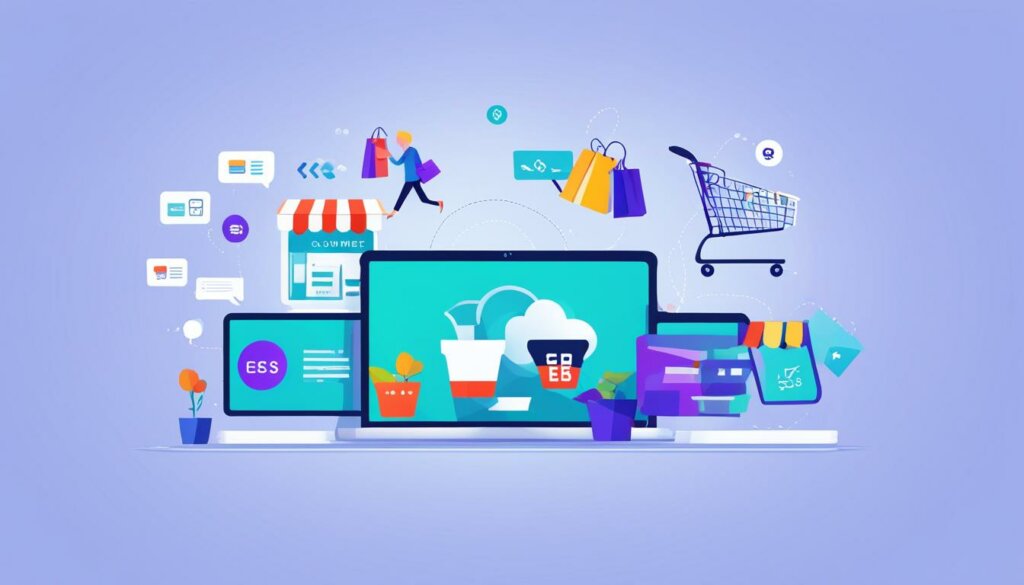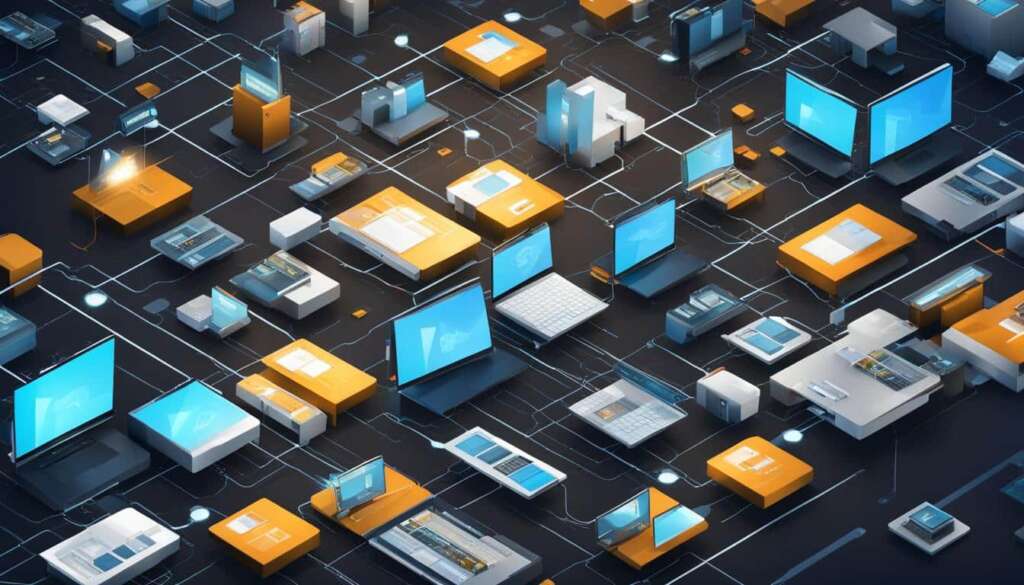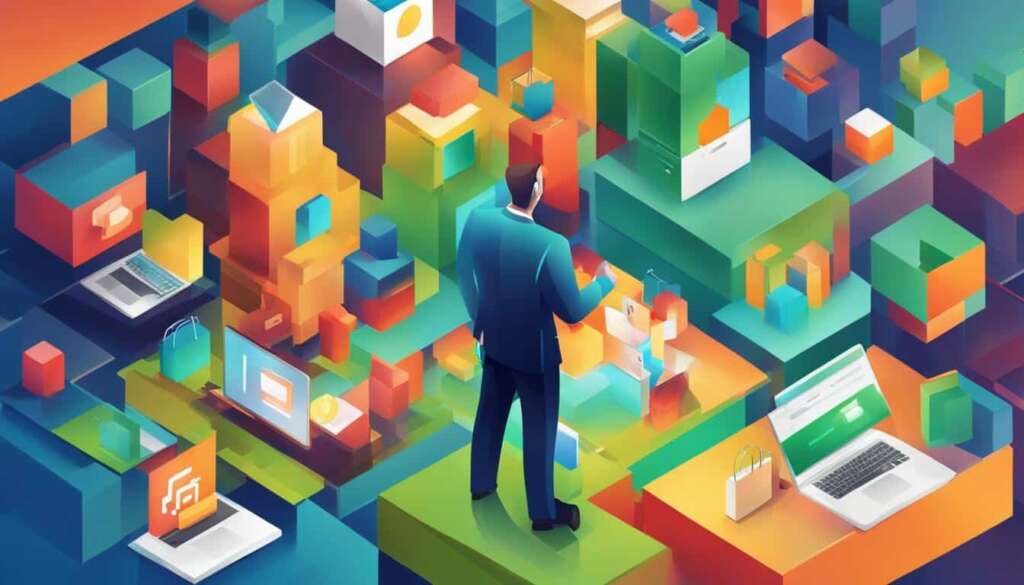Table of Contents
Electronic commerce, commonly known as e-commerce, is a fundamental part of the modern business landscape. It refers to the buying and selling of goods and services over an electronic network, most notably the internet. Whether it’s business-to-business (B2B), business-to-consumer (B2C), or consumer-to-consumer (C2C) transactions, e-commerce has become an integral part of our lives.
E-commerce platforms, such as Amazon and eBay, have revolutionized the online retail industry, offering customers a seamless shopping experience from the comfort of their own homes. Transactions that occur within this realm of digital commerce are commonly referred to as e-tail or online retail.
In the last two decades, e-commerce has experienced exponential growth. In 2011, it accounted for 5% of total retail sales, rising to approximately 16.5% by Q2 2020. Although it saw a slight decline to around 15% with the reopening of physical stores, e-commerce has undeniably become an influential force in the global marketplace.
How Does E-Commerce Work?
E-commerce, powered by the internet, enables customers to access online stores using their devices. When a customer wants to make a purchase, their web browser interacts with the server hosting the e-commerce website. The order details are then passed on to an order manager, which relays the information to databases responsible for managing inventory levels. Simultaneously, the merchant system handles payment processing, contacting the customer’s bank computer for validation. Once the order is confirmed, the order manager notifies the web server and transmits the order data to the warehouse or fulfillment department for product dispatch. This process ensures a seamless transaction for customers, whether they are purchasing tangible products or digital goods.
| E-commerce Process Components | Description |
|---|---|
| Internet | Enables customers to access online stores via their devices |
| Web browser | Interacts with the server hosting the e-commerce website |
| Server | Hosts the e-commerce website and handles incoming requests |
| Order manager | Relays order data to relevant systems and manages the order workflow |
| Databases | Manage inventory levels and store order information |
| Merchant system | Handles payment processing and contacts the customer’s bank computer for validation |
| Warehouse/Fulfillment department | Responsible for storing and dispatching products |
Whether customers are buying physical products or digital downloads, e-commerce transactions rely on the seamless coordination of various components. The internet and devices facilitate access to online stores, while web browsers and servers facilitate communication between customers and e-commerce websites. Behind the scenes, order managers ensure the smooth flow of order data from the web server to the appropriate databases, payment systems, and ultimately, the warehouse or fulfillment department.
“E-commerce transactions rely on seamless coordination between internet access, web browsers, servers, order managers, databases, payment systems, and fulfillment departments.”
With this comprehensive process in place, e-commerce has revolutionized the way businesses sell products and services, providing a convenient and efficient means of purchasing for customers worldwide.
Types of E-Commerce
E-commerce encompasses different types of transactions based on the parties involved:
- Business-to-Business (B2B): Involves the exchange of products, services, or information between businesses.
- Business-to-Consumer (B2C): Involves businesses selling products or services directly to consumers.
- Consumer-to-Consumer (C2C): Allows consumers to trade products, services, or information with each other through online platforms.
- Consumer-to-Business (C2B): Involves consumers making their products or services available online for companies to bid on and purchase.
- Business-to-Administration (B2A): Transactions between companies and government bodies.
- Consumer-to-Administration (C2A): Transactions between consumers and government bodies.
Mobile commerce, or m-commerce, refers to online sales transactions conducted using mobile devices such as smartphones and tablets.

Comparison of E-Commerce Types
| E-Commerce Type | Description |
|---|---|
| Business-to-Business (B2B) | Exchange of products, services, or information between businesses. |
| Business-to-Consumer (B2C) | Businesses sell products or services directly to consumers. |
| Consumer-to-Consumer (C2C) | Consumers trade products, services, or information with each other through online platforms. |
| Consumer-to-Business (C2B) | Consumers make their products or services available online for companies to bid on and purchase. |
| Business-to-Administration (B2A) | Transactions between companies and government bodies. |
| Consumer-to-Administration (C2A) | Transactions between consumers and government bodies. |
| Mobile Commerce (m-commerce) | Online sales transactions conducted using mobile devices. |
Advantages of E-Commerce
E-commerce offers several advantages for both businesses and consumers. Let’s explore some of the key benefits:
Around-the-Clock Availability
One of the standout advantages of e-commerce is its around-the-clock availability. Unlike physical stores with specific opening and closing hours, online stores are accessible 24/7. This means that customers can browse and shop at their convenience, without any time restrictions.
Speed of Access
E-commerce sites are designed to load quickly, providing a seamless and efficient shopping experience. Product pages, shopping carts, and checkout processes typically load within seconds, ensuring that customers can complete their purchases swiftly and without any frustrating delays.
Wide Selection of Goods and Services
Online stores have the advantage of offering a wide variety of products and services. Unlike physical stores with limited shelf space, e-commerce platforms can stock a vast array of items, providing customers with an extensive selection to choose from. This allows shoppers to find exactly what they’re looking for or discover new products they may not have come across otherwise.
Easy Accessibility
E-commerce platforms make it incredibly easy for customers to find and access the products they need. The search features and category pages of online stores enable customers to quickly navigate through different options, making the shopping experience more user-friendly and efficient.
International Reach
One of the most significant advantages of e-commerce is its ability to reach a global audience. Online stores have the potential to attract customers from around the world, expanding a business’s customer base beyond geographical boundaries. This opens up new opportunities for growth and revenue generation.
Lower Cost
E-commerce can significantly reduce costs for businesses compared to operating physical stores. With e-commerce, there’s no need to invest in expensive retail space or hire a large team of staff members. This cost-saving advantage allows businesses to offer competitive prices to customers.
Personalization and Product Recommendations
E-commerce platforms have the capability to personalize the shopping experience for each customer. By analyzing customer browsing and purchase history, online stores can provide tailored product recommendations, making it easier for customers to discover relevant items and enhancing their overall shopping experience.
These are just a few of the advantages that e-commerce brings to the table. The availability, accessibility, speed of access, wide selection, easy accessibility, international reach, lower cost, personalization, and product recommendations all contribute to the growing popularity and success of e-commerce.
Disadvantages of E-Commerce
While e-commerce offers many advantages, it is important to consider its drawbacks. Here are some key disadvantages:
Limited Customer Service
The limited customer service in e-commerce can be a significant challenge. Online support may not be readily available or equipped to address specific customer questions and concerns.
Inability to See or Touch Products
One of the main disadvantages of e-commerce is the inability to see or touch products before making a purchase. Customers have to rely solely on online images and product descriptions, which may not accurately represent the actual product.
Wait Time for Shipping
When purchasing online, customers often have to deal with a wait time for shipping. Depending on the location and shipping method, it can take several days or even weeks for products to be delivered.
Security Issues
Security issues pose a risk to both businesses and consumers in the e-commerce landscape. Scammers can create fake websites to deceive customers and steal their personal and financial information.
Limited Face-to-Face Interaction
E-commerce lacks the personal touch of face-to-face interaction that traditional brick-and-mortar stores provide. For some customers, the absence of in-person assistance and interaction may be a significant drawback.
Lack of Instant Gratification
E-commerce transactions do not offer instant gratification. Unlike physical stores where customers can take the product home immediately after purchase, online shoppers must wait for their products to be shipped.
Reliance on Technology
E-commerce heavily relies on technology infrastructure, such as websites and online platforms. Technical issues, website crashes, or connectivity problems can disrupt the shopping experience and impact customer satisfaction.
Challenges of Shipping and Fulfillment
Shipping and fulfillment processes are complex aspects of e-commerce, particularly as businesses scale and handle a larger volume of orders. Managing logistics, maintaining accurate inventory, and ensuring prompt delivery can be challenging tasks.
“E-commerce has revolutionized the retail industry, but it comes with its fair share of challenges and limitations. From limited customer service to security risks, it’s important for businesses and consumers to be aware of the potential drawbacks associated with online shopping.”
Despite these disadvantages, e-commerce continues to thrive and evolve, offering convenience and accessibility to millions of shoppers worldwide.

Conclusion
E-commerce, or electronic commerce, has transformed the way businesses operate and how consumers engage in the buying and selling of goods and services. The advantages of e-commerce are numerous, offering accessibility, a wide selection of products, and cost savings for businesses. With e-commerce, companies can reach a global audience and tailor the shopping experience to individual customers.
However, it is important to acknowledge the disadvantages that come with e-commerce. Limited customer service, the inability to physically see or touch products, and potential security concerns are some of the challenges that consumers may face. Despite these drawbacks, e-commerce is an ever-evolving industry that continues to shape the future of retail and commerce worldwide.
As technology advances and consumer behavior changes, e-commerce is likely to become even more prominent, with businesses and consumers embracing its convenience and efficiency. In a world where digital buying and selling are becoming increasingly prevalent, understanding the advantages and disadvantages of e-commerce is crucial for both businesses and consumers alike.
FAQ
What is e-commerce?
E-commerce, short for electronic commerce, refers to the buying and selling of goods and services over an electronic network, primarily the internet.
How does e-commerce work?
When a customer places an order on an e-commerce website, their web browser communicates with the server hosting the website. The order data is then relayed to an order manager, databases managing inventory levels, a merchant system for payment processing, and a bank computer. Once validated, the order manager notifies the web server and sends the order data to the warehouse or fulfillment department for product dispatch.
What are the types of e-commerce transactions?
E-commerce encompasses various types of transactions, including business-to-business (B2B), business-to-consumer (B2C), consumer-to-consumer (C2C), consumer-to-business (C2B), business-to-administration (B2A), and consumer-to-administration (C2A).
What are the advantages of e-commerce?
A: E-commerce offers several advantages, including around-the-clock availability, quick access to online stores, a wide selection of goods and services, easy accessibility through search features and category pages, international reach, cost reduction for businesses, and personalized product recommendations based on customer history.
Are there any drawbacks to e-commerce?
Yes, some drawbacks of e-commerce include limited customer service, the inability to see or touch products before purchase, wait time for shipping, potential security issues, and challenges related to technology and shipping and fulfillment.
What is the significance of e-commerce?
E-commerce has revolutionized the way businesses operate and how consumers shop. It provides convenience, accessibility, and a wide range of options for customers, while allowing businesses to reach a global audience and reduce costs.







